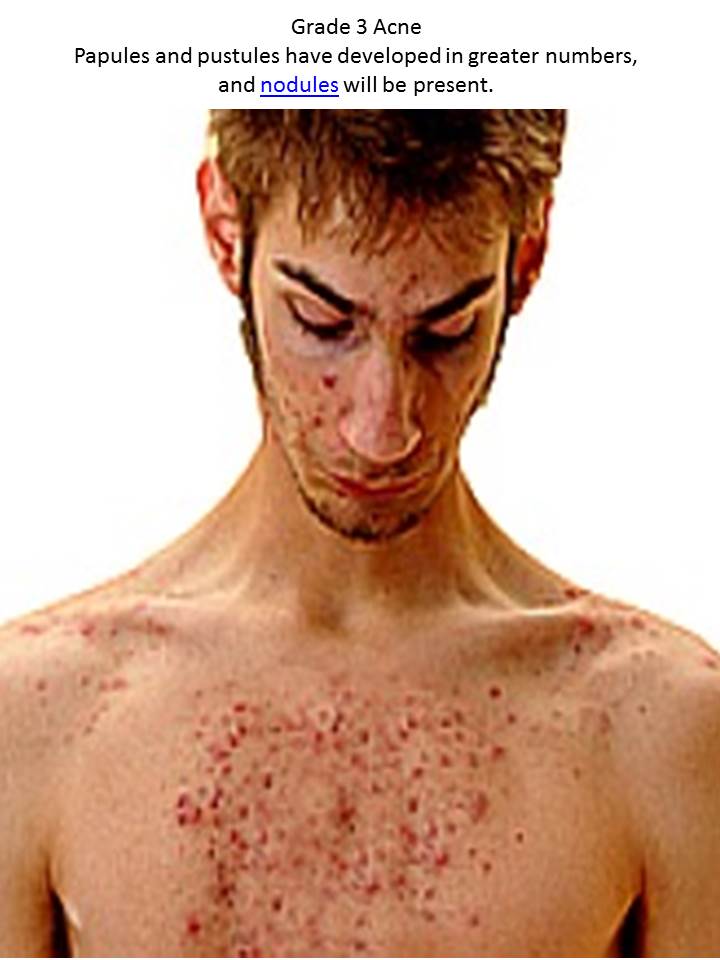Grade your Acne
Grade your Acne here – Types of Acne – Imagine Acne solutions without painful, red irritated inflamed skin. LED Skin Care Plano offers QUICK acne REMEDIES without side affects or down time. Stop acne’s destructive scarring NOW! We are a RESULTS oriented Skin Care Center with Scientifically Validated & Proven solutions. Don’t lose this war on acne one more day.
Call us now to schedule your FREE acne CONSULTATION. 972-378-0291
Understand your Grade of Acne here. Grade 1, Grade 2, Grade 3, Grade 4.
Grade IV
The most serious form of acne, Grade IV is often referred to as nodulocystic or cystic acne . The skin will display numerous papules, pustules, and nodules, in addition to cysts . There is a pronounced amount of inflammation and breakouts are severe. Cystic acne is very painful.
Acne of this severity usually extends beyond the face, and may affect the entire back, chest, shoulders, and upper arms. The infection is deep and widespread. Nearly all cystic acne sufferers develop scarring. This type of acne must be treated by a dermatologist. It tends to be hard to control, and almost always requires powerful systemic medications in addition to topical treatments.
Grade III
 This type of acne is considered severe. The main difference between Grade II acne and Grade III is the amount of inflammation present. The skin is now obviously reddened and inflamed. Papules and pustules have developed in greater numbers, and nodules will be present.
This type of acne is considered severe. The main difference between Grade II acne and Grade III is the amount of inflammation present. The skin is now obviously reddened and inflamed. Papules and pustules have developed in greater numbers, and nodules will be present.
Grade III usually involves other body areas, such as the neck, chest, shoulders, and/or upper back, as well as the face. The chance of scarring becomes higher as the infection spreads and becomes deeper.
A dermatologist should treat acne at this stage. Grade III acne is usually treated with both topical and systemic therapies available only by prescription. Left untreated, Grade III acne may progress to Grade IV.
Grade II
Grade II is considered moderate acne. There will be blackheads and milia, generally in greater numbers. You will start seeing more papules and  the formation of pustules in this stage. They will appear with greater frequency, and general breakout activity will be more obvious. Slight inflammation of the skin is now apparent.
the formation of pustules in this stage. They will appear with greater frequency, and general breakout activity will be more obvious. Slight inflammation of the skin is now apparent.
In teens, you may see the acne progress from the nose and forehead to other areas of the face. Acne may start to affect the chest and shoulders, with occasional breakouts on the back, especially in males. Adult women may find greater breakout activity in the cheeks, chin, and jaw line area, especially just before and during the menstrual cycle.
Grade II acne can still be treated at home, using over-the-counter products. In addition to a salicylic acid, a benzoyl peroxide lotion should be used daily to help kill the bacteria that cause inflamed breakouts. However, if after several weeks of home treatment your acne does not significantly improve, it is time to see a dermatologist. Grade II acne may progress to Grade III, especially if pimples are habitually picked at or squeezed.
Grade I
Grade I acne is the mildest form of acne. There may be minor pimples but they will small, appear only very occasionally, and in small numbers (one or  two). Blackheads and milia will be found, sometimes in great numbers, but there is no inflammation of Grade I acne.
two). Blackheads and milia will be found, sometimes in great numbers, but there is no inflammation of Grade I acne.
Grade I acne is commonly seen in early adolescence, especially in the nose and/or forehead. Many adults also experience grade I acne, as blackheads on the nose and forehead. Milia are commonly found in the eye area and chin.
This type of acne can be successfully treated at home using an over-the-counter product containing salicylic acid. Results generally are seen quickly. Treating acne while it is still in its early stages helps prevent acne from progressing, especially in teens. Grade I acne may progress to Grade II if left untreated.